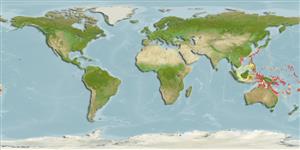>
Gobiiformes (Gobies) >
Gobiidae (Gobies) > Gobiinae
Etymology: Trimma: Greek, trimma, -atos = something crushed (Ref. 45335); lantana: Named for the tropical plant, Lantana, the inflorescences of which is an assortment of yellow, orange, purple, and reddish-pink flowers, alluding to the colourful nature of this species and the rounded blotches on the head; noun in apposition..
More on authors: Winterbottom & Villa.
Environment: milieu / climate zone / depth range / distribution range
Ecología
marino demersal; rango de profundidad 5 - 30 m (Ref. 90102). Tropical
Distribución
Países | Áreas FAO | Ecosistemas | Ocurrencias, apariciones | Point map | Introducciones | Faunafri
Western Pacific: Australasian plate and the Solomon Islands.
Tamaño / Peso / Age
Maturity: Lm ? range ? - ? cm
Max length : 2.9 cm SL macho / no sexado; (Ref. 57688)
Espinas dorsales (total): 7; Radios blandos dorsales (total): 7-9; Espinas anales 1; Radios blandos anales: 5. Diagnosis: a frontal ridge behind the orbits that slopes steeply into a wide interorbital trench
anteromedially, and into postorbital trenches laterally; posterior nasal opening separate from anterior margin of eye; second spine of first dorsal elongate, third spine not elongate; fifth pelvic fin ray branched once dichotomously; body color on anterior half off-white, grey anteriorly with grey-blue snout, red-orange trunk grading to yellow caudally, with five white dorsolateral spots between peduncle and origin of first dorsal, and two white ventrolateral spots between the peduncle and anal fin; a red-orange bar and two irregular blotches under orbit; slightly darkened posterior margin of pectoral base (Ref. 57688).
Solitary, often resting on sand or rubble bottoms of caves and ledges in 5-30 m (Ref. 90102).
Life cycle and mating behavior
Madurez | Reproducción | Puesta | Huevos | Fecundidad | Larva
Winterbottom, R. and C.A. Villa, 2003. A new species of the Trimma caesiura species complex (Teleostei: Gobiidae) from the north-eastern margin of the Australian Plate, with a redescription of the other nominal species in the complex. aqua, J. Ichthyol. Aquat. Biol. 7(1):13-28. (Ref. 57688)
IUCN Red List Status (Ref. 130435)
Threat to humans
Harmless
Human uses
Más información
PaísesÁreas FAOEcosistemasOcurrencias, aparicionesIntroduccionesStocksEcologíaDietacomponentes alimenticiosconsumo de alimentoRación
Nombres comunesSinónimosMetabolismoDespredadoresEcotoxicologíaReproducciónMadurezPuestaAgregación para la puestaFecundidadHuevosEgg development
ReferenciasAcuiculturaPerfil de acuiculturaRazasGenéticaElectrophoresesheritabilidadEnfermedadesProcesamientoNutrientsMass conversion
ColaboradoresImágenesStamps, Coins Misc.SonidosCiguateraVelocidadTipo de nataciónSuperficie branquialOtolitosCerebrosVisión
Herramientas
Special reports
Download XML
Fuentes de Internet
Estimates based on models
Preferred temperature (Ref.
123201): 26.6 - 29.3, mean 28.6 °C (based on 1091 cells).
Phylogenetic diversity index (Ref.
82804): PD
50 = 0.5000 [Uniqueness, from 0.5 = low to 2.0 = high].
Bayesian length-weight: a=0.01023 (0.00477 - 0.02194), b=3.02 (2.84 - 3.20), in cm total length, based on LWR estimates for this (Sub)family-body shape (Ref.
93245).
Resiliencia (Ref.
120179): Alto, población duplicada en un tiempo mínimo inferior a 15 meses (Preliminary K or Fecundity.).
Fishing Vulnerability (Ref.
59153): Low vulnerability (10 of 100).
Nutrients (Ref.
124155): Calcium = 861 [366, 2,844] mg/100g; Iron = 2.64 [1.32, 5.79] mg/100g; Protein = 17.4 [15.4, 19.1] %; Omega3 = 0.275 [0.095, 0.700] g/100g; Selenium = 41.7 [15.0, 106.1] μg/100g; VitaminA = 38.4 [9.4, 146.3] μg/100g; Zinc = 3.72 [2.20, 6.03] mg/100g (wet weight);
